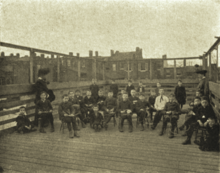Lawrence House (Baltimore)
Dr. Lawrence had no idea of a settlement in the institutional sense of the term, and merely desired a sort of social retreat, where he could change his point of view from that of a leading pastor, and observe at first-hand the conditions and the people of a congested district.
He died after a very brief illness, while the settlement in Baltimore was still only a small and obscure lodging on Parkin street.
A neighborhood club house, it aimed to be a center for things of interest to the people, to provide a place for amusements and social gatherings, and to furnish opportunities for instruction in any subject for which there was a demand.
There were many large establishments, the principal ones being the Baltimore and Ohio shops on Pratt Street, and Bartlett and Hayward's Iron Foundry.
It organized the Lawrence House Improvement Association, which published The Budget, a monthly neighborhood news sheet, for three years.
[3] The settlement maintained a library; kindergarten; playground; gymnasium; classes in chair caning, bent iron work, knife work, carpentry, drawing, athletics, embroidery, knitting, crocheting, cooking, millinery, clay modeling, arts and crafts; clubs with various interests, dramatic, debating, parliamentary drill, citizenship, story telling; game and pool rooms; dances; entertainments, concerts and lectures; and mothers' club.





